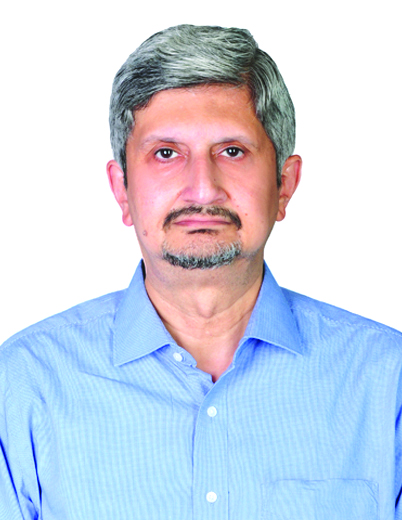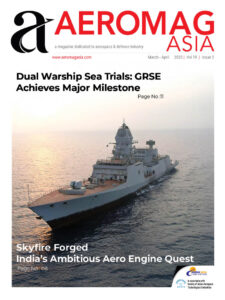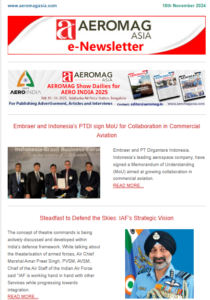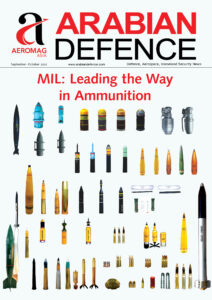
Secretary DDR&D and Chairman DRDO
As a key driver of India’s defence innovation and self-reliance initiatives, Defence Research and Development Organisation (DRDO) has been at the forefront of advancing cutting-edge technologies and forging strategic collaborations. In an interview with Aeromag, Dr Samir V Kamat, Secretary DDR&D and Chairman DRDO, provides insights into India’s evolving role in the global defence landscape. The conversation explores DRDO’s critical contributions to enhancing India’s defence capabilities, its growing presence in Southeast Asia, particularly in Vietnam, and its efforts to build partnerships that bolster regional stability. Additionally, the discussion underscores DRDO’s vision for indigenization, its strategy for international collaborations, and the pivotal role of defence startups in achieving the government’s ambitious defence export targets.

As India and Vietnam deepen their defence cooperation, what role do you foresee for DRDO in this strategic partnership? How can DRDO’s expertise in advanced defence technologies contribute to Vietnam’s defence modernization?
DRDO plays a pivotal role in fostering India’s strategic partnerships, particularly with Southeast Asian nations like Vietnam, which share common security interests in the Indo-Pacific region. For modernization of Vietnam’s defence infrastructure, DRDO’s expertise in cutting-edge technologies—such as missile systems, electronic warfare, and advanced surveillance platforms—can significantly boost Vietnam’s defence capabilities. For instance, the successful BrahMos supersonic missile program underscores our ability to collaborate on high-impact defence solutions.
DRDO can contribute through technology transfer agreements, joint development of critical defence platforms, and capacity-building initiatives in Vietnam’s defence industry.
Additionally, our work in emerging domains like cyber security, unmanned systems, and artificial intelligence opens avenues for future cooperation. Together, leveraging DRDO’s innovation ecosystem and Vietnam’s strategic priorities, we can create a robust framework for regional security and self-reliance in defence technologies.
What are the prospects for collaboration and technology transfer between DRDO and Southeast Asian nations, especially Vietnam? How do you envision these partnerships strengthening regional defence capabilities?
The prospects for collaboration and technology transfer between DRDO and Southeast Asian nations, particularly Vietnam, are both promising and transformative. Southeast Asia’s increasing defence expenditures, driven by territorial disputes and maritime security concerns, highlight a clear demand for advanced defence systems. DRDO, with its diverse portfolio of indigenously developed technologies, is well-positioned to meet this demand.
Vietnam, a key player in the Indo-Pacific, has shown interest in acquiring systems like BrahMos to enhance its maritime security. DRDO’s collaborative approach—demonstrated through successful international programs like BrahMos—can be extended to Vietnam, focusing on co-development, production, and capability enhancement. The recently signed ‘Joint Vision Statement on India-Vietnam Defence Partnership towards 2030’ lays a strong foundation for such engagements.
By transferring technology, providing training, and facilitating joint R&D projects, DRDO can help Vietnam achieve greater self-reliance in defence manufacturing. These partnerships not only strengthen bilateral ties but also contribute to regional stability. DRDO’s advanced missile systems, UAVs, and naval technologies align with the needs of Southeast Asian nations, enhancing their defence postures in a challenging security environment.

How does DRDO plan to tap into the growing defence market in Southeast Asia? What role do you see for Indian-made defence technologies in meeting the region’s security needs?
Southeast Asia represents a dynamic and growing defence market, with nations investing heavily in modernizing their armed forces. DRDO plans to capitalize on this market by leveraging India’s reputation as a reliable partner and offering cost-effective, high-performance defence solutions tailored to regional security needs.
Indian-made technologies, such as the BrahMos missile, Akash air defence systems, and various naval platforms, have proven their effectiveness in diverse operational environments. DRDO can build on this track record by actively participating in regional defence expos, fostering dialogues with ASEAN nations, and emphasizing the reliability and adaptability of Indian defence products.
Furthermore, DRDO’s focus on joint development and technology transfer aligns with the aspirations of Southeast Asian nations to strengthen indigenous defence manufacturing. By offering flexible terms and comprehensive support packages, DRDO can position Indian technologies as viable alternatives. This strategy not only addresses the region’s security needs but also enhances India’s defence exports and strategic influence.
Given the strategic importance of the Indian Ocean Region (IOR), how does DRDO plan to enhance India’s defence capabilities in this area? Are there specific technologies or collaborations being developed to address the unique security challenges of the region?
The Indian Ocean Region (IOR) is central to India’s strategic and economic interests, serving as a vital corridor for global trade and a focal point for maritime security. DRDO, recognizing these imperatives, is committed to enhancing India’s defence capabilities in the region through cutting-edge technology and strategic collaborations.
Key focus areas include the development of advanced maritime surveillance systems, anti-submarine warfare (ASW) capabilities, and next-generation naval platforms. Projects such as the Medium Altitude Long Endurance (MALE) UAVs, indigenous torpedoes, and sonar systems are designed to secure India’s maritime interests. The successful induction of platforms like the Vertical Launch Short Range Surface-to-Air Missile (VLSRSAM) system adds another layer of defence to naval assets operating in the IOR.
In addition, DRDO is strengthening partnerships with friendly nations in the region to promote interoperability and joint security measures. These collaborations include naval exercises, technology sharing, and co-development projects. By leveraging indigenous solutions and fostering regional partnerships, DRDO aims to address challenges such as piracy, and of ensuring the primacy of increasing presence of regional powers in the IOR.
DRDO and the Indian Navy have conducted back-to-back successful flight tests of the Vertical Launch Short Range Surface-to-Air Missile (VLSRSAM) recently. Could you elaborate on the strategic significance of the VLSRSAM system?
Vertical Launch Short Range Surface to Air Missile (VL-SRSAM) is a vertical launch short range surface-to-air missile having a strike range up to 80 km for Fighters aircrafts, helicopter, UAVs etc. The missile has been developed for the Indian Navy for neutralizing various aerial threats at close ranges including sea skimming targets. The VLSRSAM represents a critical advancement in India’s maritime defence capabilities, underscoring DRDO’s commitment to indigenous technological innovation.
DRDO and the Indian Navy conducted back-to-back successful flight tests of the VLSRSAM in September 2024, which was to validate multiple updated elements of the weapon system, including the Proximity Fuse and Seeker. The test reaffirms the reliability and effectiveness of the VL-SRSAM weapon system. The consecutive tests not only demonstrate the weapon system’s reliability but also validate the recent upgrades made to various components of the system. Beyond operational significance, the VLSRSAM strengthens India’s defence posture and reinforces the focus on self-reliance (Atmanirbharta) in defence production. The system will significantly enhance the operational capabilities of the Indian Navy and serve as a force multiplier.

How crucial are defence startups to India’s goal of achieving self-reliance (Atmanirbharta) in defence production? What role can they play in this mission?
India’s journey towards Atmanirbharta in defence reflects a transformative shift from reliance on imports to becoming a self-sufficient manufacturing hub. Defence startups are integral to India’s vision of achieving self-reliance (Atmanirbharta) in defence. Defence R&D has also been opened up for the startups to foster innovation and collaboration.
Startups can play a very crucial role in indigenizing components and systems that were previously imported, reducing dependency on foreign suppliers. Startups need to focus on deep tech areas like artificial intelligence, robotics, cyber security, unmanned systems, and advanced materials, including dual use technology, where rapid innovation can significantly enhance capabilities.
DRDO actively collaborates with startups through many initiatives, such as the Technology Development Fund (TDF). DRDO provide financial support, mentorship, and opportunities for startups to co-develop products with DRDO, accelerating the pace of innovation.
By partnering with startups, DRDO fosters a vibrant defence ecosystem where cutting-edge solutions can emerge rapidly to meet the evolving needs of India’s armed forces. The synergy between DRDO’s technical expertise and the startups’ agility is pivotal for creating a robust and self-reliant defence manufacturing base in India.
DRDO has successfully collaborated with international partners on projects like BrahMos and the MRSAM system. How does DRDO approach these collaborations, and what factors are considered when selecting foreign partners?
The BrahMos supersonic cruise anti-ship and land-attack cruise missile is a joint development between DRDO and Russia. The Medium Range Surface to Air Missile System (MRSAM) developed through the Indo-Israel Collaboration. DRDL Hyderabad, a DRDO Lab, has jointly developed this missile in collaboration with Israel Aerospace Industries.
The MRSAM (IAF) is an advanced network centric combat Air Defence System developed jointly by DRDO and Israel Aerospace Industries (IAI) in collaboration with the Indian industry comprising of private and public sectors including MSMEs. The robust collaboration is in line with the ‘Atmanirbhar Bharat‘ – Make in India – initiative. It further underlines the commitment of the solid partnership between IAI and the DRDO in advancing and supporting cutting-edge systems for the Indian armed forces.
The International Cooperation activities in DRDO are coordinated by our Directorate of International Cooperation (DIC), which provides a single window for all activities concerning International Cooperation. DIC guides, prioritizes and coordinates international cooperation in consonance with the vision, mission and the technology road map of DRDO. Recognising the importance of international defence R&D cooperation extend technology progress and opportunities to develop platforms, weapons, sensors and systems. DIC’s endeavour aims at Sharing, partnering and accessing the best defence technology available worldwide; reducing cost, effort and time; compressing technology capability gaps; strengthening relations with friendly countries; and presenting DRDO as technological strength for leveraging home grown technology through a joint foreign partnership.
DRDO pursues Defence Technology Cooperation with friendly foreign countries through the G2G Arrangement/ Framework. Proposals relating to Defence Technology Cooperation with foreign partners in consonance with the vision and mission of DRDO.
With the government setting an ambitious export target of Rs 35,000 crores in aerospace and defence goods and services by 2025, how is DRDO contributing to this goal, and what steps are being taken to ensure India’s defence innovations meet global market demands?
India is attaining ‘Aatmanirbharta’ in defence and is emerging as a global manufacturing hub due to the steps taken by the Government in the last few years.
DRDO is making every effort to drive innovation and bolstering exports. and to achieve the Rs 35,000 crore export target in defence goods and services by 2025. By developing world-class systems like the BrahMos missile, Akash air defence systems, and advanced naval platforms, DRDO ensures that India offers competitive, high-quality products to the global market.
Powers have been delegated to DRDO for exploring export opportunities and participation in global tenders. To meet global market demands, DRDO is focusing on tailoring its systems for international clients, ensuring compliance with global quality and certification standards. Participation in global defence expos, such as the Vietnam Defence Expo 2024, and strategic dialogues with potential buyers enhance India’s presence in the global defence market.
Further, DRDO actively supports technology transfer agreements and partnerships with private Indian defence firms to scale production and delivery capabilities. Initiatives to streamline export processes and engage with international stakeholders underscore DRDO’s commitment to promoting Indian-made defence products globally.

How do you view the Vietnam Defence Expo 2024 as an opportunity to expand DRDO’s presence and strengthen its footprint in the Southeast Asian defence market?
India and Vietnam share historical bond of friendship and DRDO’s participation in Vietnam Defence Expo 2024 will further strengthen this bond and open new arenas of future collaborations. This will also be an opportunity for the policy makers and end users in various countries to engage with DRDO for providing the customized solution to their defence requirements in association with the Indian industry.
Defence cooperation is one of the strong pillars of Comprehensive Strategic Partnership between India and Vietnam. Vietnam is an important partner in India’s Act East Policy and in the Indo-Pacific Region. Participation in the Expo underscores DRDO’s commitment to supporting Vietnam’s defence aspirations through technology transfer and joint development initiatives.
The Expo also provides a platform for DRDO to engage with regional stakeholders, fostering partnerships and exploring opportunities for co-production and R&D collaboration.











